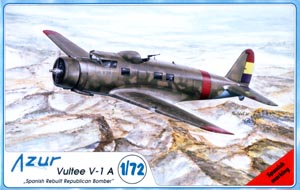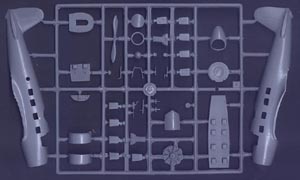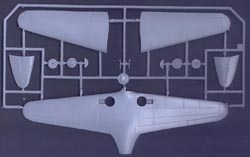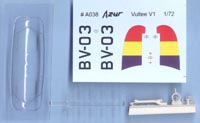Azur 1/72 Vultee V-1A |  | History Designed during the Depression, the Vultee V-1 was the first aircraft of the Vultee company. Having worked on the Lockheed Vega program with John Northrop and at Detroit Aircraft and Emsco, Jerry Vultee designed a very clean airframe that proved to be very efficient. The V-1 could carry eight passengers 750 miles and cruise at 195mph, impressive numbers for the time. American Airlines was the first customer, which resulted in a redesign due to their requirements of a two-pilot crew. This redesign resulted in the V-1A, of which 27 were built. Performance increased, as did range, but concerns about single-engine safety and the appearance of the Douglas DC-1 kept American Airlines numbers to only eleven. Other airline operators failed to materialize, but the V-1A found a niche in the form of executive transports. A deluxe version was developed, with plush interiors and a more powerful engine. In an interesting twist, the V-1A also saw service as a transport and even as a bomber in the Spanish Civil War. Only one V-1 survived to this day, this being a V-1AD that used to be the executive aircraft of William Randolph Hearst. It has been restored and is now on display at the Virginia Aviation Museum. The Kit  It’s nice to see this interest in 1930s aircraft lately, and the Vultee V-1A is an excellent example. Although there weren’t many made, the plane had a very interesting history and is an attractive plane to boot. This kit is specifically for the Spanish Civil War aircraft and features a modified upper fuselage to make room for a gun turret. The kit comes with two sprues of gray plastic parts, one small sprue of clear parts, two vacuformed canopies, and a few resin details. The decal sheet provides markings for two Republican aircraft. The kit has recessed panel lines throughout and the molding is decent throughout. It’s nice to see this interest in 1930s aircraft lately, and the Vultee V-1A is an excellent example. Although there weren’t many made, the plane had a very interesting history and is an attractive plane to boot. This kit is specifically for the Spanish Civil War aircraft and features a modified upper fuselage to make room for a gun turret. The kit comes with two sprues of gray plastic parts, one small sprue of clear parts, two vacuformed canopies, and a few resin details. The decal sheet provides markings for two Republican aircraft. The kit has recessed panel lines throughout and the molding is decent throughout.
The interior is in two sections, with a separate cockpit and cabin to build up. The cockpit is made up from a rear bulkhead and a cockpit floor, with two seats, two control columns, and two resin control wheels. The cabin consists of nothing more than a floor and six seats. A separate instrument panel finishes off the interior. There is definitely some room for improvement here, but references on the interior of the V-1A are not easy to come by. Once the fuselage is together, there probably won’t be much visible anyway.  The wings come in three pieces, with a one-piece lower wing having the proper dihedral molded in place. The tailplanes are solid right and left pieces that butt-join to the fuselage. Moving to the underside, the landing gear is pretty basic, with the gear doors taking the wheels directly. The wheels are split into right left halves. The tailwheel is solid and fits into a hole at the rear fuselage. At the other end of the fuselage, the engine is molded in one piece, with a split two-piece cowling. The exhaust stacks are resin. Final details include the top turret, various scoops, and a one-piece propeller. The wings come in three pieces, with a one-piece lower wing having the proper dihedral molded in place. The tailplanes are solid right and left pieces that butt-join to the fuselage. Moving to the underside, the landing gear is pretty basic, with the gear doors taking the wheels directly. The wheels are split into right left halves. The tailwheel is solid and fits into a hole at the rear fuselage. At the other end of the fuselage, the engine is molded in one piece, with a split two-piece cowling. The exhaust stacks are resin. Final details include the top turret, various scoops, and a one-piece propeller.
 The decal options are both camouflaged aircraft, and both probably served with Grupo 72 of the Spanish Republican Air Force. The first option is the boxtop scheme, consisting of dark green with desert yellow blotches over the top, all over middle blue. The second option is simply dark green over middle blue. Both have red wingtips, a red fuselage band, and red, yellow and purple rudder stripes. The second option also has a fuselage code of BV-03. The decals are simple, providing only the rudder striping, the fuselage codes, and propeller markings. The decal options are both camouflaged aircraft, and both probably served with Grupo 72 of the Spanish Republican Air Force. The first option is the boxtop scheme, consisting of dark green with desert yellow blotches over the top, all over middle blue. The second option is simply dark green over middle blue. Both have red wingtips, a red fuselage band, and red, yellow and purple rudder stripes. The second option also has a fuselage code of BV-03. The decals are simple, providing only the rudder striping, the fuselage codes, and propeller markings.
Conclusion This is a welcome kit of a little-known aircraft and I hope that we will soon see a civil V-1AD with a plush interior. If you are interested in Spanish Civil War aircraft or 1930s aircraft in general, this is a great kit to pick up. | 








|
